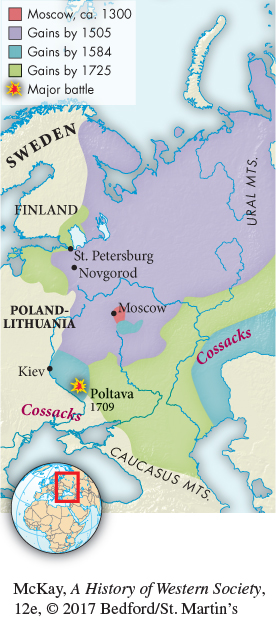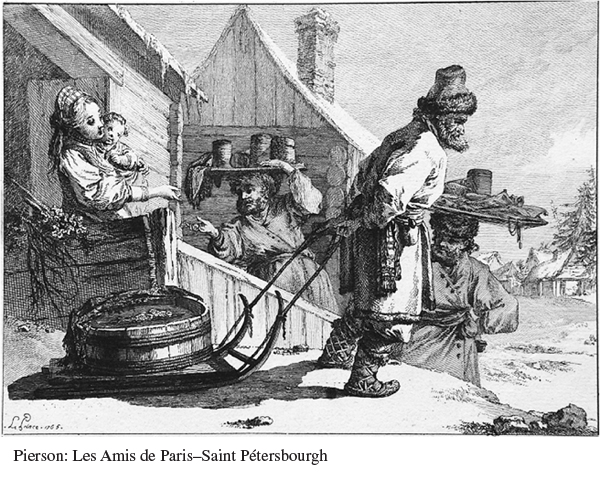A History of Western Society: Printed Page 485
A History of Western Society, Value Edition: Printed Page 470
A History of Western Society, Concise Edition: Printed Page 485
Building the Russian Empire

Developments in Russia took a chaotic turn with the reign of Ivan IV (r. 1533–1584), the famous “Ivan the Terrible,” who rose to the throne at age three. His mother died, possibly poisoned, when he was eight, leaving Ivan to suffer insults and neglect from the boyars at court. At age sixteen Ivan pushed aside his advisers, and in an awe-
After the sudden death of his wife, however, Ivan began a campaign of persecution against those he suspected of opposing him. He executed members of leading boyar families, along with their families, friends, servants, and peasants. To replace them, Ivan created a new service nobility, whose loyalty was guaranteed by their dependence on the state for land and titles.
As landlords demanded more from the serfs who survived the persecutions, growing numbers of peasants fled toward wild, recently conquered territories to the east and south. There they joined free groups and warrior bands known as Cossacks. Ivan responded by tying peasants ever more firmly to the land and to noble landholders. Simultaneously, he ordered that urban dwellers be bound to their towns and jobs so that he could tax them more heavily. The urban classes had no security in their property, and even the wealthiest merchants were dependent agents of the tsar. These restrictions checked the growth of the Russian middle classes and stood in sharp contrast to economic and social developments in western Europe.
Ivan combined domestic oppression with external aggression. His reign was successful in defeating the remnants of Mongol power, adding vast new territories to the realm, and laying the foundations for the huge, multiethnic Russian empire. In the 1550s, strengthened by an alliance with Cossack bands, Ivan conquered the Muslim khanates of Kazan and Astrakhan and brought the fertile steppe region around the Volga River under Russian control. In the 1580s Cossacks fighting for the Russian state crossed the Ural Mountains and began the long conquest of Siberia. Because of the size of the new territories and their distance from Moscow, the Russian state did not initially seek to impose the Orthodox religion and maintained local elites in positions of honor and leadership, buying their loyalty with grants of land. In relying on cooperation from local elites and ruthlessly exploiting the common people, the Russians followed the pattern of the Spanish and other early modern European imperial states.
Following Ivan’s death, Russia entered a chaotic period known as the “Time of Troubles” (1598–1613). While Ivan’s relatives struggled for power, Cossacks and peasants rebelled against nobles and officials. This social explosion from below brought the nobles together. They crushed the Cossack rebellion and brought Ivan’s sixteen-
Like their Western counterparts, the Romanov tsars made several important achievements in state-

The growth of state power did nothing to improve the lot of the common people. In 1649 a new law code extended serfdom to all peasants in the realm, giving lords unrestricted rights over their serfs and establishing penalties for harboring runaways. The new code also removed the privileges that non-
The peace imposed by harsh Russian rule was disrupted in 1670 by a rebellion led by the Cossack Stenka Razin, who attracted a great army of urban poor and peasants. He and his followers killed landlords and government officials and proclaimed freedom from oppression, but their rebellion was defeated in 1671. The ease with which Moscow crushed the rebellion testifies to the success of the Russian state in unifying and consolidating its empire.